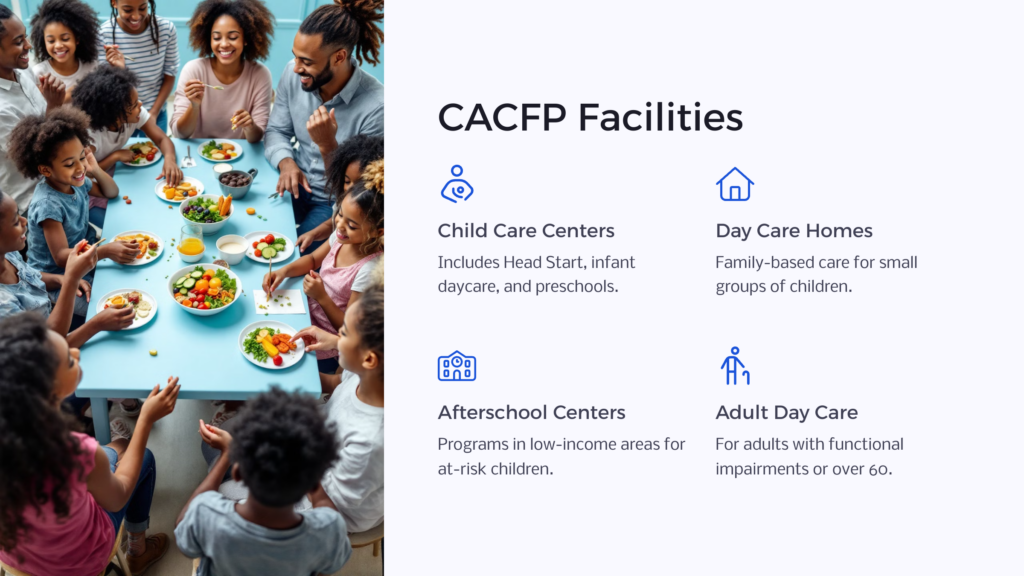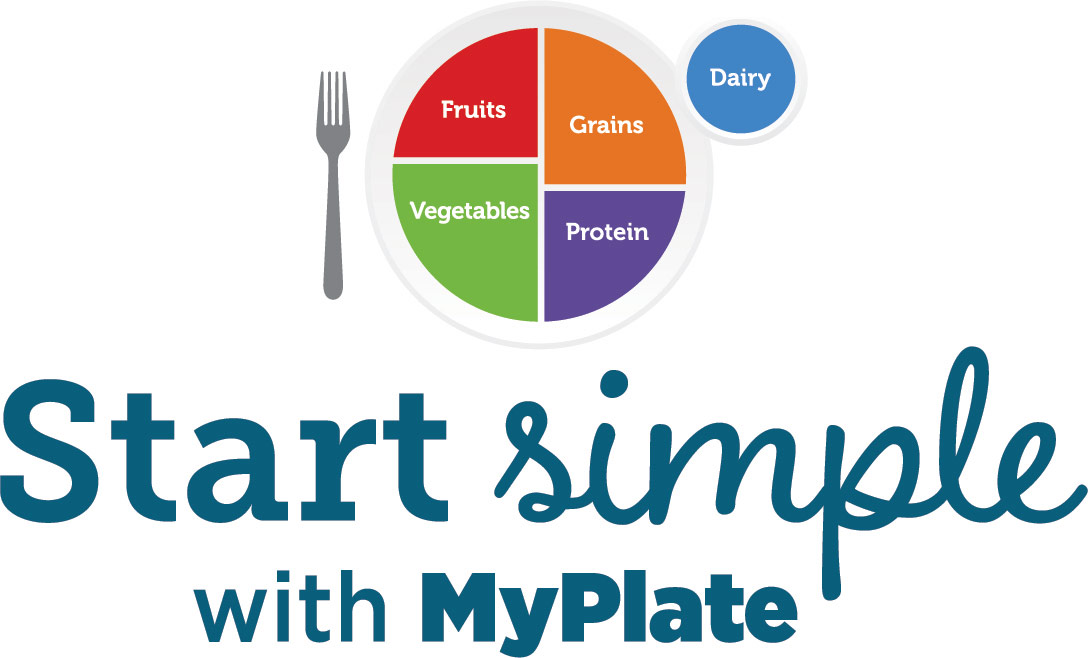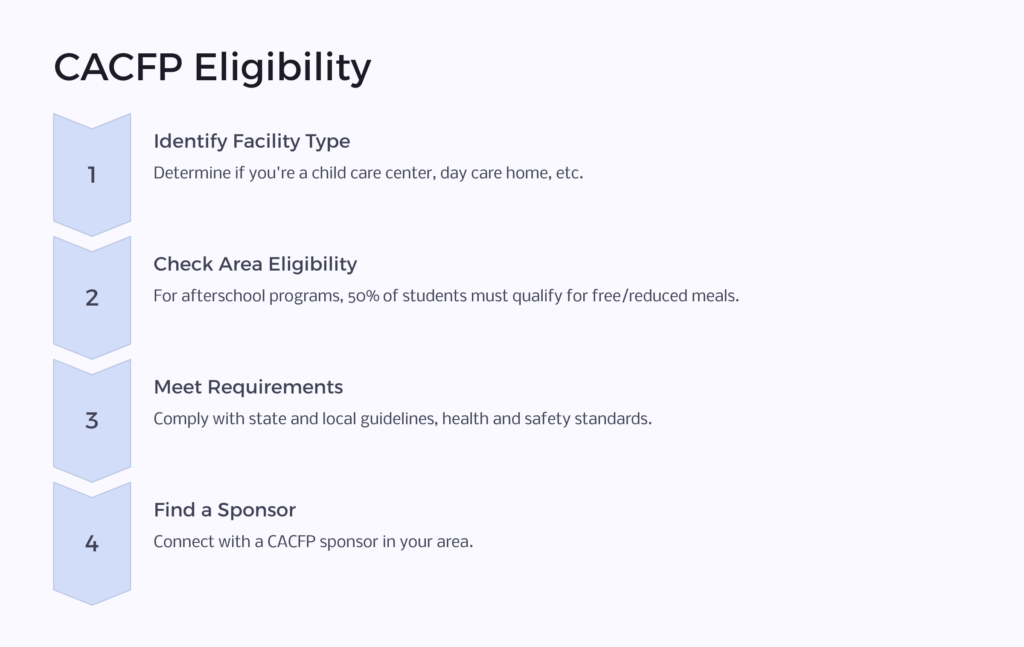The Dietary Guidelines for Americans, 2020-2025, states the importance of following a healthy diet throughout each life stage. It’s also never too early to start teaching children about nutrition, which is why the Child and Adult Care Food Program (CACFP) exists. CACFP funds healthy meals for children and adults involved in care programs to ensure that they get the nutrition they need and understand how to fuel their bodies.

5 Facilities Where CACFP Meals are Served
- Child Care Centers
- Day Care Homes
- At-Risk Afterschool Care Centers
- Adult Day Care Centers
- Emergency Shelters
The United States government ensures that children and adults are educated about diet and nutrition through various programs that reach out to schools and communities. One way the government provides this education is through the CACFP program, which gives each eligible child and adult healthy meals.
CACFP meals are nutritious meals that meet dietary guidelines set by the federal government. These requirements vary by age, as babies require a different diet than elementary school students. Adults and children who are in child care homes, day care homes, or emergency shelters may be eligible for the program.
What Is CACFP?
CACFP is a federal program that grants money to children and adults in need of healthy, wholesome meals. This program is in addition to other federal and state food assistance programs, including the Supplemental Nutrition Assistance Program (SNAP), Temporary Assistance for Needy Families (TANF), and The Emergency Food Assistance Program (TEFAP).

The CACFP program is funded by the U.S. Department of Agriculture (USDA). The USDA partners with adult day care and child care centers and homes to provide reimbursement for healthy meals. Centers must comply with set nutrition guidelines for these meals to receive reimbursement.
Whether an afterschool program or adult care home, each center in the program must go through a sponsor to receive CACFP funds. Centers can search for a sponsor in their area through the National CACFP Forum.
However, as long as the centers meet these nutritional guidelines by following a meal pattern for different age groups, they can serve the food they want at each meal or snack. Generally, a CACFP meal must consist of protein, fruits, vegetables, dairy, and grains, and snacks must contain some of these components to receive meal reimbursement.
This USDA program gives homeless shelters, family child care homes, and other centers reimbursement for each eligible meal for income-eligible areas. The reimbursement rates vary between contiguous states, Alaska, and Hawaii, and range from $0.05 to $4.28 for the 2021-2022 year.
Why Is CACFP Important?

Although many families can provide nutritious food for their children, low-income families may not have the funds available to buy and prepare healthy meals. CACFP seeks to bridge the gap between income and healthy food by offering reimbursement to child care facilities and emergency shelters that care for children and serve nutritious meals.
Additionally, adults and seniors that require around-the-clock care at an adult care center may experience the same roadblock. Low-income adults and seniors benefit from healthy food in the same way as children do, making CACFP a necessary resource for people to get the foods their bodies need.
CACFP also goes beyond ensuring that children and adults receive wholesome meals by setting meal pattern requirements for adult and child nutrition. These requirements assist centers in determining what a healthy meal consists of to help them prepare more nutritious meals in the future. Plus, the children and adults they serve can get into the habit of learning what goes into making a healthy meal.
This adult and child nutrition program and USDA also work to educate families with program information and food and nutrition resources. For instance, MyPlate, which we explain in more detail below, makes it easy for families to learn what should be on their plates.
5 Facilities Where CACFP Meals are Served
CACFP meals are reimbursed in different types of child and adult day care centers. The following adult and child care centers may receive assistance for CACFP meals.
1. Child Care Centers
Child care centers are at the crux of CACFP. The program targets different types of facilities, such as Head Start programs, infant daycare centers, preschools, and child care centers for a range of ages. Young children who are enrolled in the center and receive center-provided meals may get reimbursed meals from CACFP.
These centers are typically learning-focused and may support children from infant age through early teenage years. Qualified teachers and staff create lesson plans for different age groups, provide educational and fun activities for each enrolled participant, and assist kids with social and emotional skills.
A CACFP meal in a child care center can be breakfast, lunch, dinner, or a snack. An example meal pattern for infants six months and older includes:
- A vegetable, fruit, or both to be served at snack time
- A grain serving at snack time
- A serving of cheese, yogurt, meat, eggs, beans, or infant cereal for mealtime
- 6-8 ounces of breastmilk or formula for meal times and 2-4 ounces for a snack
Additionally, CACFP will still reimburse the child care center’s meals when a mother comes into the center to breastfeed her infant.
Older children require milk, meat or protein alternatives, vegetables, fruits, and grains for each meal and two of these five components for each snack.
2. Day Care Homes
Family day care homes differ from child care centers in that they usually care for just a few children at a time and are contained within a child care provider’s home rather than a facility. These programs are generally better for families with multiple children who prefer that siblings remain together during child care hours rather than be split into separate age groups.
Family child care homes can also benefit from CACFP funds to provide infants and children of all ages with nutritious meals cooked by the child care provider. Day care homes must follow the same child nutrition program guidelines as regular child care centers.
Providers running family child care homes can use nutrition resources from the USDA to help shape their meals. A digital cookbook can especially come in handy for home daycare providers to serve kid-approved meals that include each necessary food group.
3. At-Risk Afterschool Care Centers
An afterschool program provides learning for school-age children and teenagers after school hours. Some programs also take in kids before school, providing transportation to and from school to assist parents and guardians who work during these hours. These programs often have to serve at least one meal and snack to children, depending on how many hours they’re open before and after school.
CACFP specifically funds after school programs in low-income areas, where children are considered more at-risk for non-nutritious meals. CACFP recognizes these areas as those where at least half of its public school students qualify for free or reduced-price meals. Students must also be 18 or under at the start of the school year for the center to receive reimbursed meals for those students.
Additionally, an eligible afterschool program must prioritize learning and physical activity for students when they’re in attendance. As long as the center offers these activities to students, its meals may be reimbursed by CACFP.
4. Adult Day Care Centers
An adult day care center supports adults who need extra care and supervision during the day. These day care centers often care for seniors and adults with disabilities. Centers provide various services, including occupational and speech therapy, socialization activities, and healthcare services.
The CACFP program allows adult day care centers to receive reimbursement funds for their meals to target adult nutrition and health.
To be eligible, the day care center must serve adults who have a functional impairment or are 60 years or older. However, there is no requirement stating that the majority of participants in the program must be functionally impaired. Like child care centers, adult care centers will have a CACFP sponsor that oversees their CACFP program.
5. Emergency Shelters
Children ages 18 and younger who live in homeless shelters are automatically eligible to receive free meals through CACFP. Emergency shelters do not need approval or licensure to care for children, but CACFP requires them to meet any local and state guidelines, if applicable. Additionally, emergency facilities must meet all health and safety standards required by their state or locality to participate in the program.
Children also do not need to apply to receive free meals through CACFP if they’re in a homeless shelter. Instead, CACFP provides reimbursements for meals in group settings served in the facility to any child living with or without their families. Each facility must serve CACFP meals only to residential children rather than adults or non-residential children to be reimbursed.
What Is MyPlate?

As part of its commitment to ensuring that children and adults eat healthy meals and understand what kinds of food they should put into their bodies, the USDA offers the MyPlate program. This program is a pivotal part of CACFP, often getting referred to in resources given to each participating child and adult care food program and its families.
MyPlate is a simple way to remember how to set up your plate for meals. The MyPlate diagram includes a plate with colored portions representing fruits, grains, vegetables, protein, and dairy. These guidelines are based on the Dietary Guidelines for Americans, 2020-2025, and take into consideration the differences between each age group.
In addition to text and image resources that centers can find on the MyPlate website, they and their participating families can also use the mobile app to learn more about what to put on their plates. The app creates a plan specific to each user based on their age, sex, physical activity level, and other factors. Centers can also explore MyPlate Kitchen for recipes that align with the guidelines.
The Importance of the CACFP Meal Pattern and Program
Eating healthy nourishes the body and supports physical and mental health. CACFP commits to serving nutritious meals to each eligible child and adult in a day care program or emergency shelter who could otherwise not be getting the nutritious food they need.

Through the CACFP program, the USDA encourages eligible facilities to participate in this program designed to help at-risk communities. You can learn more about eligibility requirements for your specific type of facility by visiting the USDA’s CACFP webpage and navigating to the resources for your facility.
Additionally, families who need help serving healthy, wholesome meals should explore the many resources the USDA offers through its website. Families can learn more about nutrition guidelines for each age group using MyPlate and build healthy plates of food at each meal. Start by trying out a few recipes from MyPlate Kitchen for the family to enjoy together.
If you require immediate food assistance, help is available. Call the USDA National Hunger Hotline at 1-866-3-HUNGRY.
 Benefits.com Advisors
Benefits.com Advisors
With expertise spanning local, state, and federal benefit programs, our team is dedicated to guiding individuals towards the perfect program tailored to their unique circumstances.
Rise to the top with Peak Benefits!
Join our Peak Benefits Newsletter for the latest news, resources, and offers on all things government benefits.




















